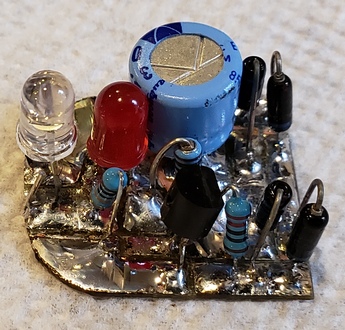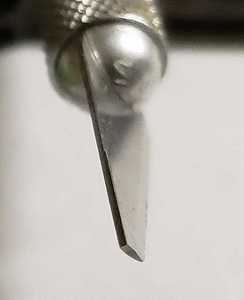Etch
My source of paper for making circuit boards is closer to home - Staples. The paper is Staples' "Picture Paper" (SKU 471861 UPC 7 18103 02238 5 or SKU 471865 UPC 7 18103 02241 5)
I remove the paper from the board by soaking in vinegar. Something in the paper reacts with the vinegar and it bubbles slowly loose. When the paper is removed, there is still a fine layer of clay on the board which I remove under running water with a soft tooth brush.
My etchant is copper cloride. It is easily made with muratic acid and hydrogen peroxide using instuctions in William Finucane's paper, Create A PCB Etchant That Automatically Improves After Each Use. The original link I used is no longer valid on the internet, and I wasn't able to find another link. The link above is to a copy of his paper.
I use an aquarium air pump and a plastic small-engine fuel filter to provide bubbles for agitation of the etching solution during the etch and regeneration of the CuCl solution.
Another dead link Cupric chloride as a board etchant has been copied here for additional reading.
I remove the paper from the board by soaking in vinegar. Something in the paper reacts with the vinegar and it bubbles slowly loose. When the paper is removed, there is still a fine layer of clay on the board which I remove under running water with a soft tooth brush.
My etchant is copper cloride. It is easily made with muratic acid and hydrogen peroxide using instuctions in William Finucane's paper, Create A PCB Etchant That Automatically Improves After Each Use. The original link I used is no longer valid on the internet, and I wasn't able to find another link. The link above is to a copy of his paper.
I use an aquarium air pump and a plastic small-engine fuel filter to provide bubbles for agitation of the etching solution during the etch and regeneration of the CuCl solution.
Another dead link Cupric chloride as a board etchant has been copied here for additional reading.
Chisel
The board shown below is a small board that I used gouging to remove the copper cladding between board tracks.
I often use an Xacto knife with a modified blade as a chisel to cut very simple PC-boards instead of etching them. The ground and honed blade shown below cuts a nice 20-mil groove through the copper layer. It is also useful for cleaning up the edges of under-etched boards.
I often use an Xacto knife with a modified blade as a chisel to cut very simple PC-boards instead of etching them. The ground and honed blade shown below cuts a nice 20-mil groove through the copper layer. It is also useful for cleaning up the edges of under-etched boards.
 Small Board Made Using Chisel |
 Chisel From Xacto Knife Blade |